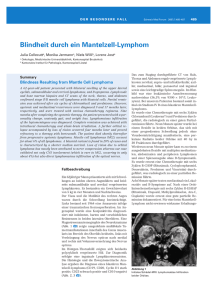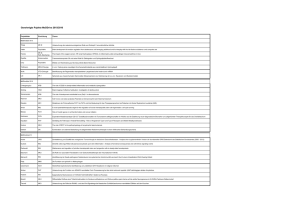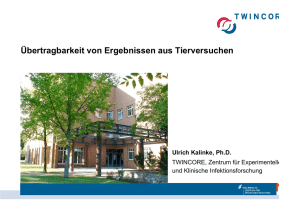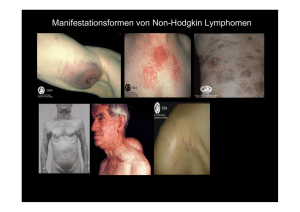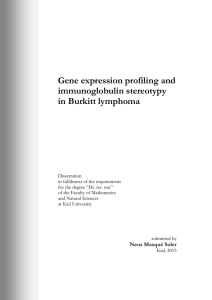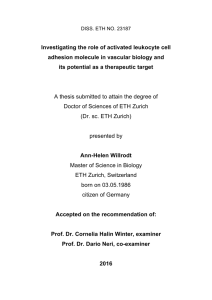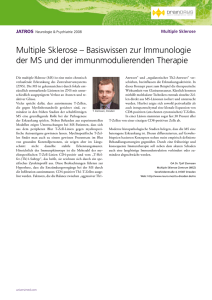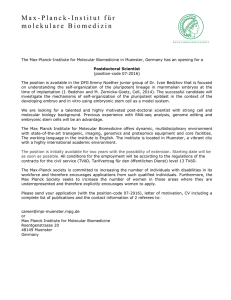150827 doktorarbeit_final_Kurzform zum hochladen
Werbung
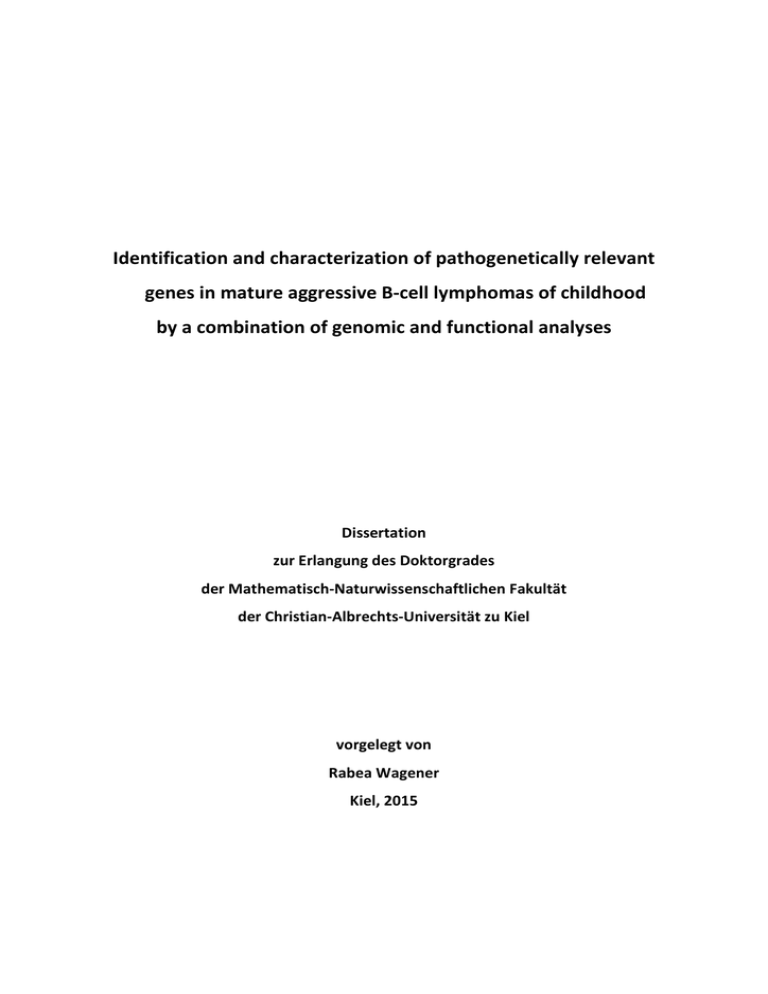
Identification and characterization of pathogenetically relevant genes in mature aggressive B-cell lymphomas of childhood by a combination of genomic and functional analyses Dissertation zur Erlangung des Doktorgrades der Mathematisch-Naturwissenschaftlichen Fakultät der Christian-Albrechts-Universität zu Kiel vorgelegt von Rabea Wagener Kiel, 2015 Erster Gutachter: Prof. Dr. rer. nat. Manuela Dittmar Zweiter Gutachter: Prof. Dr. med. Reiner Siebert Tag der mündlichen Prüfung: 25.06.2015 Zum Druck genehmigt: 25.06.2015 Gez. der Dekan Prof. Dr. rer. nat. Wolfgang J. Duschl 2 Summary Summary Burkitt lymphomas (BL) account for about 25 % of the mature B-cell lymphomas in childhood. The hallmark of BL is the chromosomal translocation t(8;14)(q24;q32), juxtaposing the MYC gene to the immunoglobulin (IG) heavy chain locus, or one of its light chain variants. These translocations result in overexpression of the oncogenic transcription factor MYC. However, the IG-MYC translocation alone is not sufficient to drive lymphomagenesis. Additional alterations are necessary for malignant transformation like mutations within CCND3 or TP53. In addition to MYC-positive BL, the existence of a subset of MYC-negative B-cell lymphoma resembling BL has been recently described. This lymphoma subset has been termed MYC-negative Burkitt-like lymphoma (mnBLL) and is characterized by a recurrent pattern of centromeric gain and telomeric loss on chromosome 11. The aims of this thesis were the identification and characterization of secondary genetic alterations in BL contributing to its lymphomagenesis. Moreover, BL should be investigated for traces of pluripotency as MYC is one of four reprogramming factors able to induce pluripotency in somatic cells. With regard to mnBLL, the aim of this thesis was the thorough description of the chromosomal, mutational and transcriptional landscape of these lymphomas in order to identify potential candidate genes contributing to its lymphomagenesis, which further should be functionally characterized. The analyses of BL were performed using 51 primary BL of the MMML cohort, which contains more than 800 molecularly characterized B-cell lymphomas, and of the ICGC MMML-Seq cohort. From the latter cohort, data from whole-genome and RNA-sequencing were available. Moreover, 25 mnBLL were analyzed of which 8 were newly recruited within this thesis. In addition, a panel of 23 B-cell lymphoma cell lines (16 BL, 3 mnBLL and 6 diffuse large B-cell lymphoma cell lines) was used for mutational screening and functional analyses. A variety of techniques was used to study the chromosomal (OncoScan DNA array, SNP 6.0 array), mutational (whole-genome, whole-exome and targeted re-sequencing, Sanger sequencing) and transcriptional (qPCR, Western blot, flow cytometry, IL10 ELISA, PluriTest) landscapes of BL and mnBLL as well as of the respective cell line models. Furthermore, the cell lines were used for various functional analyses including cell cycle and viability assays, gene knock down using lentiviral shRNA vectors or inhibition of IL10 signaling components using neutralizing IL10RA and IL10 antibodies as well as the PI3K inhibitor BKM120. Application of the PluriTest algorithm on gene expression data of 221 mature aggressive B-cell lymphomas demonstrated that BL showed a higher similarity to pluripotent stem cells (PSC) than non-BL. Nevertheless, an origin from or resemblance to cells with PSC features could not be established for BL. Analyses of the transcriptome of the BL led to the identification of a new, so far not described exon within the TERT gene. The expression of this new exon was verified in 11/11 BL cell lines and in 7/8 primary BL. Modeling of the impact of the new exon on the TERT reading frame revealed that either (i) N- or C-terminal truncated proteins might be translated or (ii) the transcript 3 Summary might be subjected to nonsense-mediated decay due to the introduction of a premature stop codon. Analyses of whole-genome sequencing data of BL and mutational screening of BL cell lines by Sanger sequencing led to the identification of frequently mutated genes so far not described in association with Burkitt lymphomagenesis. Hence, ID3 mutations were identified in 35/53 (68 %) BL and 8/12 (67 %) BL cell lines. Re-expression or overexpression of ID3 in BL cell lines induced the amount of cells in the pre-G1-phase as analyzed by cell cycle analysis, hence, further supporting the tumor suppressive function of ID3 in BL. Furthermore, 9/21 (43 %) BL and 2/16 (13 %) BL cell lines were shown to carry SMARCA4 mutations. 62 % of these mutations affected the catalytic domain. Lastly, in 6/45 (13 %) BL and 6/16 (38 %) BL cell lines PCBP1 mutations were identified which might lead to a cytoplasmatic retention and, hence, reduced function. Analysis of the copy number data determined in all 25 mnBLL led to a redefinition of the minimal region of loss in 11q which includes a minimal region of focal homozygous loss of 1.5 Mb. Moreover, recurrent, secondary alterations in mnBLL affected 6q, 13q, 18q and 12p-q. Each of these altered regions harbored potential pathogenically relevant candidate genes. Furthermore, mutations of ETS1 mapping to the region of loss in 11q were identified in 4/16 (25 %) mnBLL. Combining the results of the analyses of the chromosomal and mutational landscape with transcriptome data of 6 mnBLL provided by the MMML network project, and literature search led to the identification of 3 potential oncogenes (IL10RA, PAFAH1B2, KMT2A) and two potential tumor suppressor genes (ETS1, FLI1) in the altered 11q region. The expression profiles of these candidate genes were also analyzed in the mnBLL cell line models and were in agreement with those in the primary cases. Knock down analysis of PAFAH1B2 in a mnBLL cell line did not indicate an essential role of the PAFAH1B2 protein for the viability of the cells under the applied conditions. However, expression analysis of IL10 and IL10RA as well as inhibition of the IL10 signaling pathway components IL10, IL10RA and PI3K in B-cell lymphoma cell lines led to the identification of the IL10 signaling as a potential oncogenic signaling pathway in mnBLL. Hence, due to the interplay of IL10RA and FLI1/ETS1-induced IL10 deregulation, an autocrine IL10 signaling loop might be activated inducing PI3K signaling. The latter has been described as an oncogenic signaling pathway in BL. Taken together, the analyses performed in this thesis led to the identification of secondary alterations likely contributing to the lymphomagenesis of BL. Moreover, the investigations led to a detailed characterization of MYC-negative mnBLL on chromosomal, mutational and transcriptional level resulting in the identification of potential candidate genes. Thus, the results of this thesis provide novel insights into the pathogenetic mechanisms contributing to lymphomagenesis and, hence, may help to improve diagnostics and therapy of these mature aggressive B-cell lymphomas of childhood. 4 Zusammenfassung Zusammenfassung Ungefähr 25 % der reifzelligen B-Zelllymphome bei Kindern sind Burkitt Lymphome (BL). Charakteristisch für BL ist die chromosomale Translokation t(8;14)(q24;q32) oder eine ihrer Varianten. Durch diese gelangt das MYC Onkogen unter die Kontrolle der regulatorischen Einheiten des Immunglobulin Schwereketten oder eines der Leichtketten Gene, was zur Deregulation des Transkriptionsfaktors MYC führt. Die MYC Translokation reicht jedoch für die maligne Transformation nicht aus. Vielmehr sind sekundäre Veränderungen für die Entstehung eines BL notwendig, wie Mutationen in den Genen CCND3 oder TP53. Kürzlich konnten auch BL-ähnliche MYC-negative BZelllymphome (mnBLL) identifiziert werden. Charakterisiert sind diese mnBLL durch einen Zugewinn des zentromeren und einen Verlust des telomeren Bereichs des langen Arms von Chromosom 11. Ziele dieser Arbeit waren die Identifizierung und Charakterisierung von sekundären genetischen Veränderungen, die zu der Entstehung des BL beitragen. Außerdem sollten BL auf Anzeichen von Pluripotenz untersucht werden, da MYC einer von vier Faktoren ist, die Pluripotenz in somatischen Zellen induzieren können. Zudem sollten mnBLL umfassend im Bezug auf chromosomale, genetische und transkriptionelle Veränderungen charakterisiert werden, um potentielle Kandidatengene zu identifizieren, die zur Entstehung dieser Lymphome beitragen. Diese Kandidatengene sollten funktionell charakterisiert werden. Für die Analyse der BL standen insgesamt 51 primäre BL aus den ICGC MMML-Seq und MMML Kohorten zur Verfügung, wobei letztere insgesamt mehr als 800 molekular charakterisierte B-ZellLymphome umfasst. Für einige Fälle der ICGC MMML-Seq Kohorte waren zudem Gesamtgenom- und RNA-Sequenzierungsdaten verfügbar. Für die Charakterisierung der mnBLL wurden 25 Fälle untersucht, von denen 8 im Rahmen dieser Arbeit identifiziert wurden. Mutations- und funktionelle Analysen zu Kandidatengenen wurden an bis zu 23 B-Zell-Lymphom Zelllinien (ZL) (ZL: 16 BL, 3 mnBLL und 6 diffus-großzellige B-Zell-Lymphome) durchgeführt. Mit Hilfe verschiedener Methoden wurden chromosomale (DNA-Array: OncoScan, SNP 6.0), genetische (Gesamtgenom-, Gesamtexom-, Re- und Sanger Sequenzierung) und transkriptionelle (qPCR, Western Blot, IL10 ELISA, PluriTest, Durchflusszytometrie) Veränderungen in BL, mnBLL und den entsprechenden ZL untersucht. Zudem wurden funktionelle Analysen an ZL durchgeführt, wie z.B. Zellzyklus- und Zellviabilitätsuntersuchungen, knock down mittels lentiviraler shRNA Vektoren sowie Inhibition von Komponenten des IL10Signalwegs mit neutralisierenden IL10- und IL10RA- Antikörpern und dem PI3K-Inhibitor BKM120. Für die Pluripotenz-Analyse der BL wurden Genexpressionsdaten von 221 reifzelligen, aggressiven BZelllymphomen mittels PluriTest ausgewertet. Dabei wurde gezeigt, dass BL den pluripotenten Stammzellen (PSZ) ähnlicher sind als Nicht-BL. Eine Abstammung bzw. Ähnlichkeit der BL mit PSZähnlichen Zellen konnte jedoch nicht nachgewiesen werden. Im Rahmen der Analyse der Transkriptomdaten der BL konnte ein neues, bisher nicht beschriebenes Exon des TERT Gens 5 Zusammenfassung identifiziert werden. Dessen Expression wurde in 11/11 BL ZL und in 7/8 primären BL validiert. Vorhersagen über den Einfluss des neuen Exons auf das Leseraster des TERT Gens ergaben, dass entweder (i) C- oder N-terminal trunkierte Proteine translatiert oder (ii) aufgrund eines vorzeitigen Stopcodons Transkripte durch nonsense-mediated decay degradiert werden. Durch die Auswertung der Gesamtgenomsequenzierung der BL sowie durch gezielte Sanger Sequenzierung konnten häufig mutierter Gene identifiziert werden, die bisher nicht in Zusammenhang mit BL beschrieben wurden. So konnten ID3 Mutationen in 35/53 (68 %) BL sowie in 8/12 (67 %) BL ZL nachgewiesen werden. In Übereinstimmung mit einer tumorsuppressiven Rolle von ID3 wurden in Zellzyklusanalysen in BL ZL nach ID3 Re- bzw. Über-Expression vermehrt Zellen in der pre-G1 Phase nachgewiesen. Mutationen im SMARCA4 Gen wurden in 9/21 (43 %) BL und in 2/16 (13 %) BL ZL identifiziert. Bei 62 % der Mutationen ist die katalytische Domäne des Proteins betroffen. Mutationen in PCBP1 konnten in 6/45 (13 %) BL und 6/16 (38 %) BL ZL identifiziert werden. Diese könnte zu einer zytoplasmatische Retention führen und somit zu einer eingeschränkten Funktion. Nach Analyse der chromosomalen Veränderungen aller 25 mnBLL wurde die Größe der minimalen Verlustregion in 11q und einer darin enthaltenen 1,5 Mb großen fokalen homozygoten Deletion eingegrenzt. Außerdem wurden wiederkehrende, sekundäre Imbalancen in den Regionen 6q, 13q, 18q und 12p-q und die darin enthaltenen potentiell pathogen relevanten Kandidatengene identifiziert. In 4/16 (25 %) mnBLL wurden Mutationen des ETS1 Gens in der Verlustregion in 11q detektiert. Durch eine kombinierte Auswertung der Expressionsdaten von sechs mnBLL, der chromosomalen und genetischen Veränderungen der 11q Region sowie eine Literaturrecherche konnten drei potentielle Onkogene (IL10RA, PAFAH1B2, KMT2A) und zwei potentielle Tumorsuppressorgene (ETS1, FLI1) identifiziert werden. Deren Expressionsprofile in mnBLL ZL waren vergleichbar mit denen der primären mnBLL. Für PAFAH1B2 konnte durch knock down Experimente keine essentielle Rolle für die Viabilität von mnBLL Zellen nachgewiesen werden. Jedoch zeigen Expressionsanalysen von IL10 und IL10RA, sowie die Inhibition von IL10RA, IL10 und PI3K, dass durch das Zusammenspiel von IL10RA- und FLI1/ETS1-induzierter IL10-Überexpression ein autokriner IL10 Signalweg aktiviert werden könnte, der den bereits bei BL als onkogen bekannten PI3K Signalweg aktiviert. Zusammengefasst haben die hier durchgeführten Analysen zur Identifizierung von sekundären Veränderungen geführt, die möglicherweise zur Entstehung der BL beitragen. Außerdem wurden mnBLL umfassend auf chromosomaler, genetischer und transkriptioneller Ebene charakterisiert, wodurch potentielle Kandidatengene für deren Pathogenese identifiziert wurden. Somit tragen die Ergebnisse dieser Arbeit zu einem breiteren Verständnis der pathogenen Mechanismen bei, die zur Entstehung dieser B-Zelllymphome führen. Diese Ergebnisse können in Zukunft zur Verbesserung der Diagnostik und Therapie dieser Lymphome beitragen. 6
